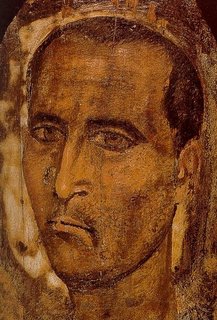Further Notes on Pasolini's Porcile
One observation about one of the final 'medieval' scenes is that it would have worked better thematically I think, if Pasolini had used wild boars instead of dogs. But he must have thought of that, so why didn't he?
Regarding a Girardian perspective on the film, it seems to me that the later sequences involving retribution between tribes and the punishment inflicted on the Young Warrior at the end look very much like ancient cultures as described by Girard. One of Girard's great insights, however, is that myths actually enable to societies to obfuscate the origins of the violence that threatens to tear them (and each other) apart. This is true in Pasolini's film only to the extent that film is itself a kind of myth, although the self-consciously unedited reel ends in the course of the movie might well be a way of practicing a kind of deflection. Even if this is true, it's a distinctly post-modern deflection of the film on its own status as 'film' (and myth) and not 'reality', rather than 'sacrificial appeasement' in place of 'violence against created beings' (which is my short version of Girard's theory of the origins of sacrifice).
Also, Girard writes (in chapter 1 of Violence and the Sacred) that the sacrificial victim is able to deflect violence because it/he/she is innocent rather than guilty, and the Young Warrior is certainly not innocent. I wrote the other day that if these were indeed rituals at the end of the movie, we would have a Girardian moment before Girard wrote his major work on the subject. I now think that even with certain ritualistic trappings and even 'blessed', what we are shown is a more extravagant perpetration of violence. From a Girardian perspective, Pasolini has merely shown us the bloody cycle that sacrifice and myth are meant to prevent.
Most importantly, the idea of Catholic priests blessing human sacrifice is offensive (from a Girardian perspective, not to mention the Catholic one) because in Christianity we have the anti-mythology that allows us to truly free ourselves from cyclical violence. Of course this is a film, and Pasolini is presenting a fiction about the violence that has certainly persisted in Christianity. While Girard acknowledges this persistence, he sees the possibility that a truer interpretation of the Gospels, or perhaps the Gospels more truly lived, offers us the freedom we are unable to attain on our own. Violence is the blood we have on our hands that we ourselves cannot remove. As I wrote, I think Girard is right, and I while I don't think Pasolini is 'wrong', I think his vision is limited, if not bass ackwards. And I still haven't gotten to the title. Stay tuned for Part III.
Regarding a Girardian perspective on the film, it seems to me that the later sequences involving retribution between tribes and the punishment inflicted on the Young Warrior at the end look very much like ancient cultures as described by Girard. One of Girard's great insights, however, is that myths actually enable to societies to obfuscate the origins of the violence that threatens to tear them (and each other) apart. This is true in Pasolini's film only to the extent that film is itself a kind of myth, although the self-consciously unedited reel ends in the course of the movie might well be a way of practicing a kind of deflection. Even if this is true, it's a distinctly post-modern deflection of the film on its own status as 'film' (and myth) and not 'reality', rather than 'sacrificial appeasement' in place of 'violence against created beings' (which is my short version of Girard's theory of the origins of sacrifice).
Also, Girard writes (in chapter 1 of Violence and the Sacred) that the sacrificial victim is able to deflect violence because it/he/she is innocent rather than guilty, and the Young Warrior is certainly not innocent. I wrote the other day that if these were indeed rituals at the end of the movie, we would have a Girardian moment before Girard wrote his major work on the subject. I now think that even with certain ritualistic trappings and even 'blessed', what we are shown is a more extravagant perpetration of violence. From a Girardian perspective, Pasolini has merely shown us the bloody cycle that sacrifice and myth are meant to prevent.
Most importantly, the idea of Catholic priests blessing human sacrifice is offensive (from a Girardian perspective, not to mention the Catholic one) because in Christianity we have the anti-mythology that allows us to truly free ourselves from cyclical violence. Of course this is a film, and Pasolini is presenting a fiction about the violence that has certainly persisted in Christianity. While Girard acknowledges this persistence, he sees the possibility that a truer interpretation of the Gospels, or perhaps the Gospels more truly lived, offers us the freedom we are unable to attain on our own. Violence is the blood we have on our hands that we ourselves cannot remove. As I wrote, I think Girard is right, and I while I don't think Pasolini is 'wrong', I think his vision is limited, if not bass ackwards. And I still haven't gotten to the title. Stay tuned for Part III.


2 Comments:
I'm intrigued by your notes on this movie and the Girardian lens, and I like the transition from Franz to Blaise, but I expected a bunch of saints for All Saints Day. I'm disappointed.
And I'm ashamed. I'll backdate a post for the first saint listed for All Saints Day, St. Amabilis. Amabilis, I'd like to add, is latin for "loveable".
Post a Comment
<< Home